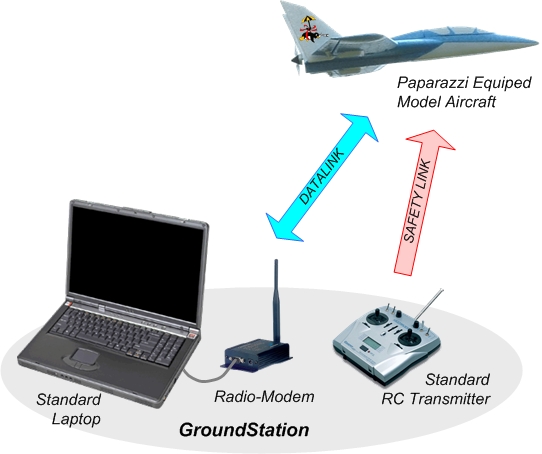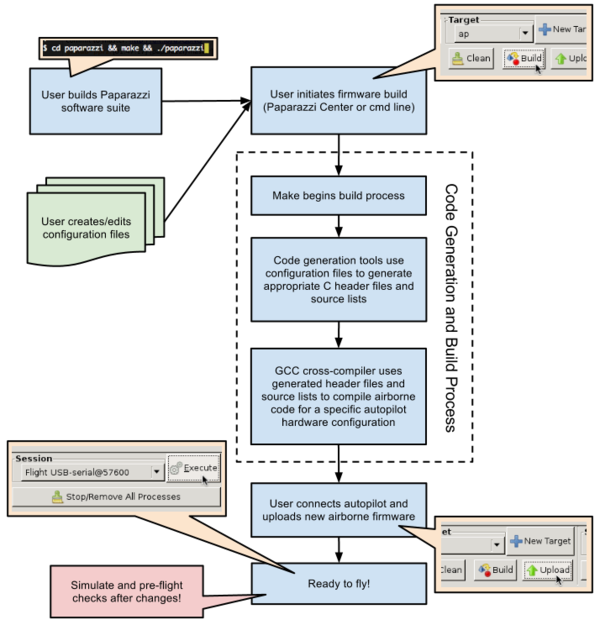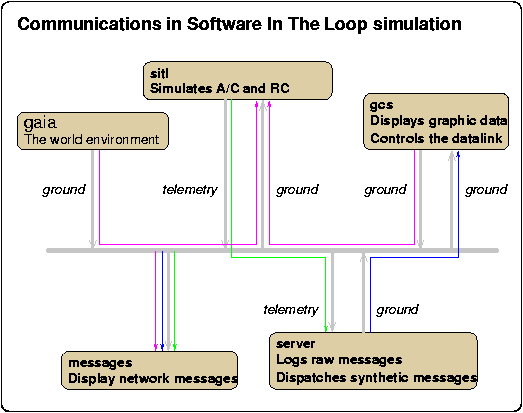Difference between revisions of "Overview"
m (detail for ir sensor) |
|||
| Line 18: | Line 18: | ||
** Attitude Sensors | ** Attitude Sensors | ||
*** [[IMU]], or | *** [[IMU]], or | ||
*** [[IR]] sensors (fixed-wing only) | *** [[IR]] sensors (fixed-wing only, if you have no IMU) | ||
** [[GPS]] Receiver | ** [[GPS]] Receiver | ||
** [[Sensors/Airspeed|Pressure]] sensors | ** [[Sensors/Airspeed|Pressure]] sensors | ||
Revision as of 05:23, 21 May 2013
Paparazzi is a complete system of open source hardware and software for Unmanned Aircraft Systems (UAS), including both the airborne autopilot as well as complete ground station mission planning and monitoring software utilizing a bi-directional datalink for telemetry and control.
Aircraft
Paparazzi was originally designed for use with fixed-wing aircraft, but has since been expanded to include rotorcraft and work is underway to properly support hybrid aircraft. The hardware required for each type of airframe is essentially the same, and software uses many of the same elements with some parts interchanged. For example, fixed-wing stabilization control loop requirements are different than rotorcraft, while a datalink driver is essentially identical.
The Airframe
The Paparazzi airborne system is highly configurable and can be used to autonomously operate almost any airframe. It is currently in use on airframes ranging from 20cm to 4.3m, and 100g to 25kg. In the early days of the project, slow and stable airframes such as the venerable Twinstar and Microjet were favored, but today the system is employed in a wide variety of high performance aircrafts, many with little or no natural stability, and many designed specifically around the Paparazzi system.
The Paparazzi software suite by default supports traditional fixed-wing and multicopter airframes. The customizability of the software and support for a variety of hardware results in a flexible system capable of controlling many airframe configurations. In addition, hybrid aircraft development is underway and with some effort, additional systems such as traditional helicopters, gliders, marine and ground vehicles could be added (though are currently not supported by default).
The key components in a Paparazzi UAV are:
- Main Autopilot Board
- Sensors, including:
- Datalink Radio Modem
- RC Receiver (safety link)
- Actuators (servos)
- Propulsion System (electric motor(s)/speed control(s) or IC engine(s))
- Batteries
- Payload (example: camera and video transmitter)
In general, some components can be omitted or additional ones added, depending on the system requirements. For example, if no ground station is used (besides an RC transmitter), the datalink radio is not required.
An example overview diagram of a fixed-wing system layout is presented. The classic MicroJet is illustrated here. Different configurations are certainly possible!

|
|
The User's Gallery and Booz User List show some of the many Paparazzi aircraft.
Airborne Electronics
Controller Board
Over the years, a large number of autopilot main boards have been designed and tested for use as part of the Paparazzi system. Historically, Atmel AVR MCUs were used, though this transitioned to Philips/NXP ARM7 LPC21xx microcontrollers. More recently, support for the STMicroelectronics STM32Fxxx series of microcontrollers has been introduced. These boards include one or two microcontrollers and the required connectors to handle the servos, motor controllers, sensors, RC receiver, radio modem, and a variety of payloads.
All of the hardware design files are available under the GPL and/or CC-BY-SA licences in the hardware file repository.
Each control board was designed to meet some specific application. As such, most boards (even old designs) are still actively used. The software side is maintained to support all of the different hardware (exception being obsolete AVR-based boards). Some boards have onboard sensors for tighter integration while others separate all sensors from the main board to help with challenges mounting equipment and overcoming EMI, RFI and/or mechanical vibration issues.
Work has also been completed in integrating Linux-based single board computers such as the Gumstix product line. These devices provide the computing power required for very advanced aircraft control schemes or payloads.
More details on the controller boards are available on the Autopilots page.
Sensors
Paparazzi autopilots can interface with virtually any type of sensor. Many are supported by default, and adding support for new sensors is relatively straightforward given the software framework.
Again, any Paparazzi-designed hardware sources are available under the GPL and/or CC-BY-SA licences in the hardware file repository.
Attitude
Historically, fixedwing aircraft used a set of 6 orthogonal infrared temperature sensors to estimate the orientation of the aircraft relative to the warm earth and cold sky. The IR system provides a robust and absolute attitude estimate that is immune to vibration and disorienting launches, wind gusts, or stalls. More recently, full inertial measurement solutions have been integrated into the fixedwing systems. Paparazzi also uses conventional inertial systems on rotorcraft. There is software sources for a wide variety of inertial systems, including inexpensive analog accelerometers and gyroscopes, small paparazzi-targeted purpose-built IMUs, or commercially available AHRS solutions.
Some autopilots have an IMU integrated on board while others use an external IMU. All autopilot main boards support both inertial and IR attitude sensing solutions.
See the IMU page and the IR page for more details.
GPS
Generally, a standard GPS receiver from u-blox is used, either as an external stand-alone unit , or as a fully integrated package, like in the Tiny series of autopilot. This brand of GPS receiver is used because of its high performance and very efficient binary protocol. While more expensive than some other GPS units, the tighter integration, lower parsing overhead and generally better quality data makes it more advantageous. Support is also available for MediaTek MT3329 chipsets with DIYDrones firmware. In addition, limited or experimental support is available for SkyTraq binary and traditional NMEA sentence GPS data.
GPS is required for UAV localization. It is used in the autonomous navigation stages of flight control to enable waypoint navigation, as well as to supplement Attitude Heading and Reference System (AHRS) state estimates (especially in fixedwing aircraft).
More details are available on the GPS page.
Other Sensors
A wide variety of other sensors may be useful onboard a UAV, either as part of flight control or just for measurement. Some examples of currently supported sensor types include:
- differential pressure (airspeed)
- barometric pressure (altitude)
- sonar (altitude)
- current (energy consumption)
- temperature and humidity (meteorological measurements)
Communications
Airborne hardware also includes communications devices: Radio Modem (Datalink) & RC Receiver (Safety Link).
Telemetry and Datalink
Any wireless device providing a serial link can be used for the telemetry and the telecontrol (Datalink). Historically, even audio-channel based telemetry has been used. Bi-directional communication is generally recommended, but not required in very special applications. The most common datalink device is the venerable XBee series of radio modem. Other systems include powerful long range radios such as the Digi 9XTend modules, cellular network communications or satellite communications with Iridium satellite modems.
The telemetry part of the link (from aircraft to ground) is used to obtain status information about the UAV to aid an operator and monitor mission progress, as well as provide some payload data. The datalink or telecontrol part of the link (from ground to aircraft) is used to send commands to the aircraft and interact with a payload. Example: telemetry provides the current location of the aircraft with can be viewed on the GCS map in real time, while the datalink allows a user to move a waypoint on the ground to modify the path the aircraft will follow in real time.
More details on communications hardware are available on the Modems page.
Safety Link
A traditional radio control transmitter and receiver pair is used to provide a manual control option for the UAV. The airborne hardware and software support the connection to a standard (patched) radio-control receiver. The autopilot reads output from the R/C receiver onboard the aircraft and decides what control mode is desired. When in manual mode, a safety pilot on the ground may use the R/C transmitter to control the aircraft. In the case of rotorcraft, some level of computer control is usually necessary to maintain stable flight, even under "manual" control. The Paparazzi manual bypass or "Fly-by-Wire" system has been finely tuned over many years and provides a reliable method of providing override control even though the autopilot always remains inline between R/C receiver and actuators.
While this link is not required for actual autonomous flights, it may help during the tuning of a new aircraft and is usually considered as an important safety control redundancy.
Paparazzi can support almost all types of R/C system.
Further information can be found on the RC_Receivers_and_Radios page.
Example Setups and Tutorials
List coming soon!
Getting Hardware
Because the Paparazzi project is open source, anyone can manufacture their own hardware. Alternatively, if this isn't really an option due to time or expertise, various vendors offer Paparazzi hardware or other useful products.
Please see the Get_Hardware page for details.
Airborne Software
The airborne portion of the software runs on the main autopilot control board.
The Paparazzi autopilot provides by default the following features:
Fixed-Wing
- Manual control with the RC Transmitter
- RC receiver (PPM signal or Spektrum) decoding
- Servos and motor controller (PWM signal) control
- Control with augmented stability (named AUTO1)
- Autonomous navigation (named AUTO2) in 3D, including
- Waypoint navigation
- Segment and circle navigation
- Altitude hold, glide following
- High level flight plan language execution (takeoff, landing, sequence, loops, surveys, goto, etc.)
- Advanced failsafe configurations (geo-fencing, lost link behaviour, etc.)
- Telemetry to the ground station (sensor data, navigation data, status information, etc.)
- Telecontrol (datalink) from the ground station (navigation control, waypoint modifications, tuning, etc.)
New features can be added by only changing a configuration setting
Rotorcraft
Description coming soon!
Configuration
The autopilot code is written in C and features a level of hardware abstraction. Paparazzi uses code generation to allow for easy configuration through XML files. This build process is illustrated here. The primary configuration files are the:
- Airframe XML File
- defines all autopilot parameters, including hardware configurations and control loop default set values
- Flight Plan XML File
- defines autonomous flight behaviors and high level fail-safes
In addition, the following files are also used (either default or modified):
- Radio XML File
- describes valid radio transmitter behavior used under manual control
- Telemetry XML File
- describes what messages are sent and at which rate a message is send
- Settings XML Files
- describes the available and valid settings for various autopilot parameters as seen in the GCS used for e.g. inflight tuning
Code is segregated into two processes respectively handling the fly by wire (manual control) and the autopilot itself (stabilization and navigation). Usually, rotorcraft do not use a direct manual control mode as some level of computer-aided stabilization is often needed to maintain stable flight. In addition, onboard code is split between periodic tasks and event tasks. Periodic tasks are scheduled time sensitive tasks executed at specific periodic intervals. Examples include navigation actions, control loops and periodic telemetry messages. Event tasks are carried out in response to something. For example, receiving new GPS data or a datalink message. The fly by wire process is always given priority.
Ground Control Station (GCS)
The ground control station is where an operator interacts with an Unmanned Aircraft System. It generally consists of several parts, usually providing feedback about UAV activity, allowing command and control of the aircraft and providing a method of override control for the system.
Ground Computer
The software suite was developed to be run on a i386 architecture based on the Debian GNU/linux operating system. Currently, Ubuntu is a popular and well supported choice for Paparazzi, while Mac OS X is also supported. Selection of a computer will vary based on application, but a small notebook easy to take to the flying field with good battery life is typical.
For more information on operating system options, please visit the Installation page.
Ground Software
Just as important as the software running onboard the main autopilot board in the air is the corresponding software on the GCS, providing the human interface for configuration, monitoring and control of the UAS.
The Paparazzi software suite is fully featured with solid core functionality, easy customization and flexible extensibility. It supports all types of airframes, as well as multiple UAVs.
The software suite mainly provides
- compilation tools to produce the airborne software from the configurations and source code
- a GUI to control and interact with the UAV(s) during flight as well as mission planning and simulation
- a basic simulator to ease the development of flight plans and verify some airborne code behaviour
- a data logging system with plot-based viewer for real-time and post-flight analysis
- a number of utilities for communicating with the UAV and other agents
- a number of tools for calibration, etc.
- a control panel GUI for configuration and program management
- an easy method of extending functionality with the Ivy Bus
Groundside Datalink
Paparazzi offers several possibilities to supervise the UAV flight from the ground. The default one uses a bidirectionnal wireless modem which supports both telemetry (downlink) and telecontrol (uplink), as described above in the Airborne Telemetry and Datalink section. Thanks to this datalink, flight parameters are available in real time and full control of the navigation and tuning of one or several aircraft is possible from the ground station.
The ground side of the link usually consists of a matching radio modem, like an XBee, connected to the ground station computer over USB or serial port.
Groundside Safety Link
The ground side of the safety link usually consists of a radio control transmitter (and safety pilot). It is used to provide manual control of the aircraft, as described above in the Airborne Safety Link section.
System Architecture
The following figure shows the main agents (processes or programs), of the system: one (or several) aircraft and the distributed ground architecture (usually distributed on a single computer):
The UAV (in blue) is navigating autonomously and is monitored and controlled from the ground (in brown). The ground control station (GCS), or gcs agent, provides a graphical user interface with telemetry data received by the link agent which manages the ground-based radio modem. The link agent distributes telemetry data across the network (a single computer, a local network or the internet) where it can be used locally or remotely by the:
- server - an agent that logs, distributes, and preprocesses these messages for the GCS and other agents
- messages - a real-time numeric display of all telemetry data
- A number of other useful agents, including:
- a GCS-based flight plan editor to modify waypoints
- a UAV simulator to test flight plans and code modifications
- a real-time plotter for graphical telemetry data visualization
- a log plotter for graphical telemetry visualization after a flight
All of these processes run simultaneously and each module is independently launched and configured from Paparazzi_Center, where further detail can be found.
First experiments with the system should be with the simulator where everything runs on a local machine. The configuration is then slightly different:
Here the aircraft and its radio link are replaced by the simulator. An optional gaia agent is also available to introduce some environmental parameters such as wind, infrared contrast, GPS quality, and time scale reference.
Because of the modular nature of the Paparazzi software suite, custom agents enhancing functionality are (relatively) easy to create and integrate with existing software. Some examples include:
- a weather station interface
- an external gps position display
- a joystick interface for controlling aircraft or payloads from the GCS
Payloads
Paparazzi is designed to interface with a wide variety of payloads. The airborne board can control many servos for autonomous and/or manual Pan/Tilt camera systems or other mechanical payloads, SPI, I2C, and GPIO connections are available to connect digital devices (i.e. lights or digital camera shutter), and analog inputs are available to interface with just about any sensor imaginable. The associated software is easily integrated into the open-source code. Some boards can also be connected to a Gumstix Computer for highly sophisticated payload software applications, as described in OMAP Integration.
Disclaimers
It should be understood that smooth, reliable autonomous flight is a great feat and will require significant time and effort to achieve, even with a highly evolved open system like Paparazzi. The time required will vary based on experience, aircraft, and luck. From experience however, users can expect to spend a similar amount of time learning and configuring Paparazzi as they may with any of the commercially available systems.
Linux itself can pose quite a challenge to install, configure, and learn. We strongly urge new users to Contact someone from the Paparazzi team before beginning any hardware investment as we can help you get the most out of the system.
The Paparazzi software and hardware are distributed without any guarantee, in particular they are not certified by any national or international authorities. Before flying, please refer to your country national aviation regulation for Unmanned Aerial Systems, or the one of the country you intend to overfly.



